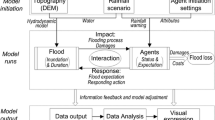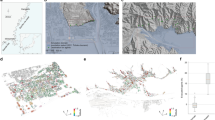Abstract
The increasing frequency and intensity of hurricane hazards have raised the urgency of improving hurricane warning effectiveness, especially in terms of motivating the evacuation of people living in high-risk areas. Traditional warnings for hurricanes have limitations of sending a general message for coarse spatial scales (e.g., county level) and do not include specific risks and orders for residents in distinct areas of finer scales. To overcome these limitations, geo-targeted hurricane warning systems have been proposed, but in practice, the existing systems have low accuracy because they neglect environmental factors when defining warning zones. Extant literature has focused on optimizing the geo-delivering process of warnings with limited efforts on geo-defining warning zones. It is still unclear to what extent the geo-targeted warnings motivate residents to evacuate from high-risk areas before a hurricane. Therefore, we developed an agent-based model (ABM) to simulate residents’ evacuation decision-making under geo-targeted warnings, which were generated based on characteristics of both hurricane hazards and the built environment. We used forecasted information of Hurricane Dorian as a case study; then conducted the ABMs under geo-targeted warnings, a general warning, and warnings based on storm surge planning zones; then we compared the three outcomes. The research finds an effective way to geo-define warning zones using the built environment data. The result suggests that geo-targeted warnings can motivate more residents in high-risk areas to evacuate. These findings contribute to the understanding of the effect of geo-targeted warning on evacuation and suggest the importance of warnings with more specific contents for finer spatial scales.










Similar content being viewed by others
Availability of data and material
All the data used in this research (e.g., hurricane data, land use data and census tract data) are public-accessible, which can be downloaded based on the websites in the reference list. The simulation outcomes are listed as maps in the supplementary material.
References
Adam C, Gaudou B (2016) BDI agents in social simulations: a survey. Knowl Eng Rev 31(3):207–238. https://doi.org/10.1017/S0269888916000096
Anthony KE, Cowden-Hodgson KR, Dan O’Hair H, Heath RL, Eosco GM (2014) Complexities in communication and collaboration in the hurricane warning system. Commun Stud 65(5):468–483. https://doi.org/10.1080/10510974.2014.957785
Baker EJ (1991) Hurricane evacuation behavior. Int J Mass Emerg Disasters 9(2):287–310
Bakkensen LA, Mendelsohn RO (2016) Risk and adaptation: evidence from global hurricane damages and fatalities. J Assoc Environ Resourc Econ 3(3):555–587
Bernardini G, Quagliarini E, D’Orazio M (2016) Towards creating a combined database for earthquake pedestrians’ evacuation models. Saf Sci 82:77–94. https://doi.org/10.1016/j.ssci.2015.09.001
Bhattacharya M, Roy S, Mistry K, Shum HP, Chattopadhyay S (2020) A privacy-preserving efficient location-sharing scheme for mobile online social network applications. IEEE Access 8:221330–221351
Bonabeau E (2002) Agent-based modeling: methods and techniques for simulating human systems. Proc Natl Acad Sci USA 99:7280–7287. https://doi.org/10.1073/pnas.082080899
Bostrom A, Morss R, Lazo JK, Demuth J, Lazrus H (2018) Eyeing the storm: How residents of coastal Florida see hurricane forecasts and warnings. Int J Disaster Risk Reduct 30:105–119. https://doi.org/10.1016/j.ijdrr.2018.02.027
Bui L (2019) Social media, rumors, and hurricane warning systems in Puerto Rico. In: Proceeding of the 52nd Hawaii international conference on system science http://hdl.handle.net/10125/59704.
Busemeyer JR, Diederich A (2002) Survey of decision field theory. Math Soc Sci 43(3):345–370. https://doi.org/10.1016/S0165-4896(02)00016-1
Chen X, Meaker JW, Zhan FB (2006) Agent-based modeling and analysis of hurricane evacuation procedures for the Florida Keys. Nat Hazards 38(3):321. https://doi.org/10.1007/s11069-005-0263-0
CNN (2019) Hurricane Dorian intensifies as it heads for US https://www.cnn.com/us/live-news/hurricane-dorian-august-2019/index.html.
Dawson RJ, Peppe R, Wang M (2011) An agent-based model for risk-based flood incident management. Nat Hazards 59(1):167–189. https://doi.org/10.1007/s11069-011-9745-4
Eiser JR, Bostrom A, Burton I, Johnston DM, McClure J, Paton D et al (2012) Risk interpretation and action: a conceptual framework for responses to natural hazards. Int J Disaster Risk Reduct 1:5–16. https://doi.org/10.1016/j.ijdrr.2012.05.002
FEMA (2019) Flood Zones. https://www.fema.gov/flood-zones. Accessed 09 September 2020
Federal Communications Commission (2020) Wireless Emergency Alerts (WEA) https://www.fcc.gov/consumers/guides/wireless-emergency-alerts-wea. Accessed 09 September 2020
Gonzales D, Kraus L, Osburg J, Shelton SR, Woods D (2016) Geo-targeting Performance of Wireless Emergency Alerts in Imminent Threat Scenarios: Volume 1: Tornado Warnings. https://www.dhs.gov/sites/default/files/publications/Rand_WEA-Final%20Report-VOL1-8-26-16-508C.pdf. Accessed 09 September 2020
Goodie AS, Sankar AR, Doshi P (2019) Experience, risk, warnings, and demographics: predictors of evacuation decisions in Hurricanes Harvey and Irma. Int J Disaster Risk Reduct 41:101320. https://doi.org/10.1016/j.ijdrr.2019.101320
Hao H, Wang Y (2020) Leveraging multimodal social media data for rapid disaster damage assessment. Int J Disaster Risk Reduct 51:101760. https://doi.org/10.1016/j.ijdrr.2020.101760
Haghani M, Sarvi M (2018) Crowd behavior and motion: Empirical methods. Transp Res Part B: Methodological 107:253–294. https://doi.org/10.1016/j.trb.2017.06.017
Hasan S, Ukkusuri S, Gladwin H, Murray-Tuite P (2011) Behavioral model to understand household-level hurricane evacuation decision making. J Transp Eng 137(5):341–348. https://doi.org/10.1061/(ASCE)TE.1943-5436.0000223
Huang SK, Lindell MK, Prater CS (2016) Who leaves and who stays? a review and statistical meta-analysis of hurricane evacuation studies. Environ Behav 48(8):991–1029. https://doi.org/10.1177/0013916515578485
Huang SK, Lindell MK, Prater CS (2017) Multistage model of hurricane evacuation decision: empirical study of hurricanes Katrina and Rita. Nat Hazards Rev 18(3):05016008. https://doi.org/10.1061/(ASCE)NH.1527-6996.0000237
Joo J, Kim N, Wysk RA, Rothrock L, Son YJ, Oh YG, Lee S (2013) Agent-based simulation of affordance-based human behaviors in emergency evacuation. Simul Model Pract Theory 32:99–115. https://doi.org/10.1016/j.simpat.2012.12.007
Jumadi CS, Quincey D (2017) A conceptual design of spatio-temporal agent-based model for volcanic evacuation. Systems 5(4):28. https://doi.org/10.3390/systems5040053
Lee S, Son YJ, Jin J (2010) An integrated human decision-making model for evacuation scenarios under a BDI framework. ACM Trans Model Comput Simul (TOMACS) 20(4):1–24. https://doi.org/10.1145/1842722.1842728
Leon J, March A (2016) An urban form response to disaster vulnerability: improving tsunami evacuation in Iquique, Chile. Environ Plan B: Plan Design 43(5):826–847. https://doi.org/10.1177/0265813515597229
Liang W, Lam NSN, Qin X, Ju W (2015) A two-level agent-based model for hurricane evacuation in New Orleans. J Homeland Secur Emerg Manag 12(2):407–435. https://doi.org/10.1515/jhsem-2014-0057
Miami-Dade County (2015) FEMA flood zone. https://gis-mdc.opendata.arcgis.com/datasets/ef3bdd041b2e424695eb4dfe965966c4_0. Accessed 09 September 2020
Miami-Dade County (2020) Storm surge planning zones. https://www.miamidade.gov/global/emergency/hurricane/storm-surge-zones.page. Accessed 09 September 2020
Morss RE, Demuth JL, Lazo JK, Dickinson K, Lazrus H, Morrow BH (2016) Understanding public hurricane evacuation decisions and responses to forecast and warning messages. Weather Forecast 31(2):395–417. https://doi.org/10.1175/WAF-D-15-0066.1
NAS (2018) Emergency alert and warning systems: current knowledge and future research directions. Washington DC
National Hurricane Center (2020a) Hurricanes in history. https://www.nhc.noaa.gov/outreach/history/. Accessed 09 September 2020
National Hurricane Center (2020b) Tropical cyclone report: Hurricane Dorian https://www.nhc.noaa.gov/data/tcr/AL052019_Dorian.pdf. Accessed 09 September 2020
National Research Council (2013) Geotargeted alerts and warnings: report of a workshop on current knowledge and research gaps. Washington DC
Nejat A, Cong Z, Liang DA (2016) Family structures, relationships, and housing recovery decisions after Hurricane Sandy. Buildings 6(2):16. https://doi.org/10.3390/buildings6020014
NOAA (2019a) NHC data in GIS formats. https://www.nhc.noaa.gov/gis/. Accessed 09 September 2020
NOAA (2019b) Dorian graphics archive: 5-day forecast track and watch/warning graphic. https://www.nhc.noaa.gov/archive/2019/DORIAN_graphics.php?product=5day_cone_with_line. Accessed 09 September 2020
Onggo BS, Busby J, Liu Y (2014) Using agent-based simulation to analyze the effect of broadcast and narrowcast on public perception: a case in social risk amplification. Proceedings of the Winter Simulation Conference 2014: 322–333. https://doi.org/10.1109/WSC.2014.7019899
Parker AM, Jackson BA, Martinez AR, Sanchez R, Shelton SR, Osburg J (2015) Exploring the effect of the diffusion of geo-targeted emergency alerts: the application of agent-based modeling to understanding the spread of messages from the wireless emergency alerts system. Washington DC
Rey W, Mendoza ET, Salles P, Zhang K, Teng YC, Trejo-Rangel MA, Franklin GL (2019) Hurricane flood risk assessment for the Yucatan and Campeche State coastal area. Nat Hazards 96(3):1041–1065
Reynolds B, Seeger MW (2005) Crisis and emergency risk communication as an integrative model. J Health Commun 10(1):43–55. https://doi.org/10.1080/10810730590904571
Rovere A, Casella E, Harris DL, Lorscheid T, Nandasena NA, Dyer B et al (2017) Giant boulders and Last Interglacial storm intensity in the North Atlantic. Proc Natl Acad Sci 114(46):12144–12149. https://doi.org/10.1073/pnas.1712433114
Sadri AM, Ukkusuri SV, Murray-Tuite P, Gladwin H (2015) Hurricane evacuation route choice of major bridges in Miami Beach. Florida. Trans Res Rec 2532(1):164–173. https://doi.org/10.3141/2532-18
Smith SK, McCarty C (2009) Fleeing the storm (s): an examination of evacuation behavior during Florida’s 2004 hurricane season. Demography 46(1):127–145. https://doi.org/10.1353/dem.0.0048
Sun GB, Oreskovic NM, Lin H (2014) How do changes to the built environment influence walking behaviors? a longitudinal study within a university campus in Hong Kong. Int J Health Geographics 13:10. https://doi.org/10.1186/1476-072X-13-28
Sutton J, Kuligowski ED (2019) Alerts and warnings on short messaging channels: guidance from an expert panel process. Nat Hazards Rev 20(2):04019002. https://doi.org/10.1061/(ASCE)NH.1527-6996.0000324
Ukkusuri SV, Hasan S, Luong B, Doan K, Zhan X, Murray-Tuite P, Yin W (2017) A-RESCUE: An agent based regional evacuation simulator coupled with user enriched behavior. Netw Spatial Econ 17(1):197–223. https://doi.org/10.1007/s11067-016-9323-0
University of Florida GeoPlan Center (2019) Florida parcel data statewide–2018. https://www.fgdl.org/metadataexplorer/explorer.jsp. Accessed 09 September 2020
U.S. Census Bureau (2019) 2015 census block groups in Florida (with selected fields from the 2014–2018 American community survey). https://www.fgdl.org/metadataexplorer/explorer.jsp. Accessed 09 September 2020
Villegas J, Matyas C, Srinivasan S, Cahyanto I, Thapa B, Pennington-Gray L (2013) Cognitive and affective responses of Florida tourists after exposure to hurricane warning messages. Nat Hazards 66(1):97–116. https://doi.org/10.1007/s11069-012-0119-3
Wang WJ, Haase TW, Yang CH (2020) Warning message elements and retweet counts: an analysis of tweets sent during Hurricane Irma. Nat Hazards Rev 21(1):04019014. https://doi.org/10.1061/(ASCE)NH.1527-6996.0000351
Wei HL, Lindell MK, Prater CS (2014) “Certain death” from storm surge: a comparative study of household responses to warnings about Hurricanes Rita and Ike. Weather, Climate, Soc 6(4):425–433. https://doi.org/10.1175/WCAS-D-13-00074.1
Wood MM (2018) Geotargeted alerts and warnings. People, the Earth, Environment and Technology, International Encyclopedia of Geography. https://doi.org/10.1002/9781118786352.wbieg1150.pub2
Yao F, Wang Y (2020) Domain-specific sentiment analysis for tweets during hurricanes (DSSA-H): A domain-adversarial neural-network-based approach. Comput Environ Urban Syst 83:101522. https://doi.org/10.1016/j.compenvurbsys.2020.101522
Zhu Y, Xie K, Ozbay K, Yang H (2018) Hurricane evacuation modeling using behavior models and scenario-driven agent-based simulations. Procedia Comput Sci 130:836–843. https://doi.org/10.1016/j.procs.2018.04.074
Acknowledgements
This material is based upon work supported by the National Science Foundation under Grant No. 2028012, the early-career faculty start-up fund, and graduate research assistantships at the University of Florida. Any opinions, findings, and conclusions or recommendations expressed in this material are those of the authors and do not necessarily reflect the views of the National Science Foundation and the University of Florida.
Funding
This material is based upon work supported by the National Science Foundation under Grant No. 2028012 (PI: Wang, Yan), the early-career faculty start-up fund (recipient: Wang, Yan) and Graduate Research Assistantships (recipient: Gao, Shangde) at the University of Florida.
Author information
Authors and Affiliations
Contributions
Shangde Gao and Yan Wang were responsible for conceptualization and methodology. Shangde Gao performed data curation, formal analysis, validation, writing—original draft and visualization. Yan Wang performed writing—review & editing, supervision, project administration, funding acquisition.
Corresponding author
Additional information
Publisher's Note
Springer Nature remains neutral with regard to jurisdictional claims in published maps and institutional affiliations.
Supplementary Information
Below is the link to the electronic supplementary material.
Rights and permissions
About this article
Cite this article
Gao, S., Wang, Y. Assessing the impact of geo-targeted warning messages on residents’ evacuation decisions before a hurricane using agent-based modeling. Nat Hazards 107, 123–146 (2021). https://doi.org/10.1007/s11069-021-04576-1
Received:
Accepted:
Published:
Issue Date:
DOI: https://doi.org/10.1007/s11069-021-04576-1




